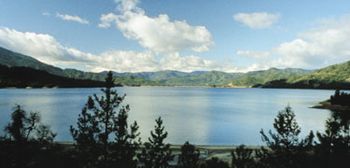Clear Creek (Sacramento River tributary) facts for kids
Quick facts for kids Clear Creek |
|
|---|---|

Whiskeytown Lake on Clear Creek
|
|
| Country | United States |
| State | California |
| Region | Shasta Trinity |
| Physical characteristics | |
| Main source | Damnation Peak Trinity Mountains, Shasta-Trinity National Forest 5,080 ft (1,550 m) 40°57′31″N 122°31′45″W / 40.95861°N 122.52917°W |
| River mouth | Sacramento River Girvan 415 ft (126 m) 40°30′20″N 122°22′04″W / 40.50556°N 122.36778°W |
| Length | 60.6 mi (97.5 km) |
| Basin features | |
| Basin size | 249 sq mi (640 km2) |
| Tributaries |
|
Clear Creek is a stream in northern California. It is also known as Ínaam in the Karuk language. This creek flows into the upper Sacramento River. It is an important part of the local water system.
Contents
Where Does Clear Creek Flow?
Clear Creek is about 60.6 miles (97.5 km) (97.5 km) long. It starts in the Trinity Mountains. These mountains are located between Shasta Lake and Trinity Lake. The creek flows through the Shasta-Trinity National Forest.
Journey to the Sacramento River
The creek first flows into Whiskeytown Lake. This lake is a reservoir created by the Whiskeytown Dam. After leaving the lake, Clear Creek continues south. It eventually joins the Sacramento River. This meeting point is near a place called Girvan.
Water for the Central Valley
A special tunnel helps move water from Whiskeytown Lake. This tunnel is called the Spring Creek Tunnel. It sends water directly to Keswick Reservoir. Both Whiskeytown Lake and Keswick Reservoir are part of the Central Valley Project. This project helps manage water for many uses in California.
A Glimpse into History
Clear Creek has a special place in California's history. In 1848, a man named Pierson B. Reading found gold here. This discovery was an important event during the California Gold Rush. The spot where he found gold is now a California Historical Landmark. This means it's a protected site because of its historical importance.

